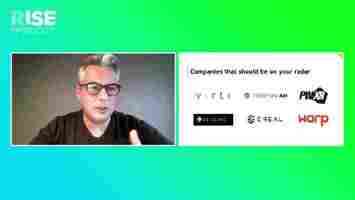Oh no… ‘Senior Clubhouse Executive’ is now a thing
If you’ve been online at all in the last few months — which, let’s face it, you have — then you’re bound to have caught a glimpse of the annoying Clubhouse hype.

Clubhouse is an invitation-only audio-chat social networking app… so yet another place where ‘innovative minds’ can speak their minds unhindered. Only this time around it’s all live audio so you can hear their unfiltered and unstructured thoughts in real-time… yay, sign me up…
But now the app has gone far beyond being just hype. It isn’t just the lone ‘office Chad’ who’s raving on about the amazing talk he hosted on the exclusive invite-only platform with his fellow hustlers. Now it’s actually become a profession . Battenhall , a London-based communications agency, is hiring a Senior Clubhouse Executive . Yup, for reals.
I’ve got to admit I’m pretty skeptical about Clubhouse’s value (you couldn’t tell, right?). However, I’m on a professional journey to get to the bottom of jargon startup job titles — so I reached out to Battenhall’s founder and CEO, Drew Benvie , who’s responsible for the title, to dig deeper into its inception and meaning.


First up, WTF is Clubhouse?
Essentially, it’s a live audio social network that launched in private beta back in April 2020. Clubhouse’s focus on ‘just audio’ differentiates it somewhat from other social media platforms as users can enter different ‘rooms’ and listen in on live user-hosted interviews and sessions.
You also have the opportunity to chime in just by clicking on the ‘raise your hand’ icon and the host can then let you share your two cents. On top of that, you can also create your own room for open, social, or closed chats.
The reason why I like to dunk on the platform — besides being a general party-pooper — is its annoying ‘tech bro’ vibe.
Case in point, there’s already a host of support apps for the platform and even a concierge service . This feels like peak Clubhouse to outside skeptics.
I was hoping I wouldn’t have to try Clubhouse out — ever — but alas, the gods had something else in store for me. Before getting Benvie’s insights on the platform, I’d have to try it out for myself.
First up, I hadn’t realized through all the hype that you can only access Clubhouse with an iPhone . It’s still in beta testing and currently only available for iOS. So despite having an invite, the first thing I had to do was procure an iPhone just to log in.
When I finally got one, what did I see? Bad moderation and unstructured sessions. It felt like I was listening to a chaotic, unedited podcast.
Quartz Daily Brief pointed out that Clubhouse basically shows how not to run a meeting. Its summary was pretty much in line with my experience:
To be fair, I wasn’t logging on out of a genuine interest in a certain topic, so that needs to be taken into account. But what’s Drew Benvie’s take? He’s an early adopter and pushing his company to invest in a Senior Clubhouse Executive. Is Benvie ready to defend the quality of Clubhouse content?
“I joined a session the other day that lasted five hours . I only stayed for 10 minutes and said to myself ‘wow, this is rubbish.’ Luckily, I was on mute… or at least I hope I was,” Benvie says.
Ouch.
For Benvie, the nice way to describe the majority of shows on Clubhouse is “free-flowing,” but usually that tends to mean a lack of moderation and proper structure. A big percentage of sessions also seem to be just a series of loosely coupled together self-promotional appearances that offer no value to anyone.
“But that’s actually okay,” Benvie explains. “I think it’s fine for a new social network to have some rubbish on it, because it’s a sign that it’s innovating. I wouldn’t write it off just because there’s some poor content on there now.”
It’s all about serendipity
But, Benvie says it’s much easier to fix poor content than replicate the excitement Clubhouse creates — which it’s darn good at.
While Benvie feels it’s currently a struggle to find good content on Clubhouse — both due to the sheer volume of bad stuff and search/recommendation options still being in development — he’s undeniably hooked.
“I mean, I’m the CEO of a company, it doesn’t quite make sense how much time I’ve put into this,” Benvie chuckles. “But I’m kind of an accidental early-adopter and I just wanted to dive in.”
“I would say Clubhouse’s real strength is that it’s created a platform for serendipity,” Benvie explains. “Strip everything else away, when high profile people turn up unannounced and take everybody by surprise, that’s what I find really interesting.”
Just the other day, Benvie caught Mark Zuckerberg’s surprise appearance on Clubhouse. It felt much more personal because the audience actually has a chance to chime in.
Benvie has also had serendipitous moments in rooms he himself has hosted. Damian Collins, one of the members of the UK parliament you’ll see grilling social media executives in the courts, joined his room.
“I spoke to him directly for 20 minutes in front of a relatively small audience. I mean, this is the kind of individual that I don’t think would ever have opened an email from me asking to speak privately or publicly. This is when I saw the true potential of Clubhouse to bring people together in a different and authentic way.”
Make way, Senior Clubhouse Executive coming through
Ok… so the person responsible for bringing a Senior Clubhouse Executive into the world isn’t a super crazy evangelist for Clubhouse — just a curious accidental early-adopter trying to understand the platform.
So what is up with this new job title, is this just a marketing ploy concocted by Battenhall? I mean, I bit.
Benvie cracks up. “No, it’s a real role.”
At Battenhall, a ‘Senior Executive’ is a standard job title for someone with three to five years experience in communications consulting. People in those roles come from a wide variety of backgrounds — journalists, YouTubers, etc. — but the new hire will spend most of their time on Clubhouse, so it was added to the title.
But why put so much money on Clubhouse? Battenhall could’ve easily hired a Junior Clubhouse Executive, but instead, Benvie is committing them fully to this strategy. The answer is actually pretty simple.
“The key thing about this role is that it’s come via demand from clients of ours, asking us to help them understand and create an authentic presence on Clubhouse,” Benvie explains. “The role came about quite organically. While I and others at Battenhall have spent time on the social network, we realized that somebody who’s highly experienced with the app would be a perfect fit for us — and our clients.”
About whether the title will stick around forever, Benvie does concede that even though Clubhouse is doing for audio what Twitter did for text messaging and YouTube for video, it could still lose its prevalence. Snapchat introduced Stories, but now platforms like Instagram are more famous for the feature.
However, the interest from clients and the growth of Clubhouse’s userbase make it clear the title will be important for the foreseeable future.
Hello… is it me you’re looking for?
Fair enough, but Battenhall hasn’t found its Senior Clubhouse Executive yet — so let’s take a look at the required skills. Well, they need to have vast experience on a platform that’s been around for… not even a year. Oh, and it’s still in beta.
Well, you can still have loads of experience, relative to the platform’s lifespan. Benvie says they’ll be taking into account technical skills and relevant backgrounds during the interviews — which will take place on Clubhouse on February 22 (sadly they’ll be in private rooms, so I can’t heckle the candidates).
I still find it fun to bash on Clubhouse and the vibe around it, but I’ve got to admit I’m a tiny bit convinced by Benvie’s and Battenhall’s earnest approach to the social network’s possibilities.
And while I’m still not completely sure I want to do this to the world, you can apply here to become a Senior Clubhouse Executive. I hope history will treat me kindly.
Got any weird jargon job titles at your startup that actually kinda make sense? Let us know at [email protected] !
The 8 best and worst decisions I made in my first year as a CMO
On average, CMOs have 40 months to prove their effectiveness. When it comes to startups, the figure is half that: you either bring explosive growth or get replaced.

CMOs in SaaS companies must understand both the market and the audience, shape positioning, and support unit economics. They are also responsible for brand awareness, acquisition and retention, product launches, customer loyalty, and about a million other things.
The story of Admixer’s marketing department is an unconventional one: I had to staff a team of 17 people for a mature adtech company from scratch. We had a year to relaunch the marketing of a company that had nearly 300 employees in five countries, an established image in the market, and many inside stereotypes about B2B marketing.
In this article, I have collected eight of the best and worst decisions I made during the first year as a CMO of a large B2B corporation. Let’s begin with my four best ones.
1. No micromanagement
Some might think it’s crazy, but the only person on the team, besides me, who had a background in adtech industry before, was a PR manager. I didn’t have a choice as there are not many adtech companies or specialists in Ukraine. Yet, I had a clear hiring strategy in mind: fill every position with overqualified specialists.
I selected them based on two criteria: a clear specialization and the ability to work autonomously. Since I had to provide product onboarding for a bunch of people and establish communication between offices simultaneously, I didn’t have much time to work on my team’s hard skills.
As a result, I never had to solve any problems for my employees and could focus on strategy and vision instead. We hired the first junior specialist a year later when we’d already achieved significant results.
2. Honesty in communication with С-suite
When you start a team from scratch, you will incur some losses: after all, they don’t know all the business specifics or fully understand customers’ pain points yet.
Our company has a line of complex products and solutions so when I didn’t understand something, I admitted it right away. We didn’t pretend that we were 100% sure that there was no inaccuracy in our blog post or that we could predict how our message would resonate with the audience.
Despite the constant criticism, I repeatedly asked the stakeholders not to expect our department to become adtech experts in a short period of time. The world didn’t fall apart because of this, and people from other departments began to help us more willingly.
Thanks to honest communication, we managed to generate 10% of all leads in a year with the help of our company blog.
3. Multi-touch funnels for big clients
The Power Law Distribution works well for us — we get the majority of inbound leads from SEO. Yet, we needed a different approach to attract larger clients.
That’s how we got three divisions working together: the event department organizes an online conference, the content team publishes interviews with the speakers, and our online education platform invites conference speakers to present lectures.
After several rounds of nurturing, part of the speakers or their companies become leads for the Business Development department. By doing this, our number of leads grew by 70% in the first year.
4. Open reporting within the company
Our team turned out to be in charge of introducing sophisticated analytics for marketing itself, the sales department, and other business units. All the reports were publicly available for employees.
We created easy-to-digest reports on incoming leads, which made it possible to see which clients the company should focus on, and which requests aren’t worth the time of the business development or support teams. Our marketing report has become a decision-making tool for the department heads.
The company is now simplifying its product line so that marketing can focus on the most revenue-generating products.
Now it’s time to move on to my worst decisions — all the things I wished I would have done differently.
1. Putting off thorough product onboarding
On average, it takes six to 12 months to understand an adtech product. I wanted to hack the system and relied on speed rather than depth or expertise… which resulted in tons of negative feedback from product owners who expected high-quality marketing materials.
Processing numerous edits and comments took ages and was exhausting for the team. Eventually, we had to pause and delve into the details of each product. But even to this day, each content piece goes through several stages of validation.
My lesson here is that it’s better to organize a quality product onboarding process at the beginning and invest enough time in it rather than learning on the go.
2. Failing to hire a marketer with a development background
Over the year, we launched a content site, a platform for e-learning, landing pages for three conferences, redesigned our blog, and moved our main website to WordPress. I outsourced the development so as not to distract the main team from product development.
However, six months later, I realized that my team was ineffective in setting development tasks. They didn’t always know what could be automated or how to implement certain features easily, while the outsourcing team didn’t have enough involvement in our projects.
As a result, we spent more time and money on task clarification than on technical implementation. I wish I hired a strong marketer with experience in development earlier.
3. Underestimating PR
Over the first year, we reached more than 80 earned publications in the media. I underestimated this channel before, as it’s difficult to measure and assess with the right metrics.
Yet, the effect of PR was dramatic: our brand search traffic increased 11 times, and now, during negotiations, we often hear that someone has read an article about us. If I had realized earlier that PR could bring such results, I would have invested a lot more resources into it.
4. Lack of explanation of my decisions
Everyone likes to tell marketers how to do their jobs. Unlike development or support, everyone seems to know how to “do marketing right” despite hardly understanding how it works nowadays.
While I was annoyed that everyone was telling me how to do my job, I missed one crucial thing: not everyone understands the true meaning of certain metrics. People with no marketing background tended to measure our team’s effectiveness by vanity indicators, like the number of followers on LinkedIn.
So, I should’ve explained in more detail how I set KPIs to the team so that all departments could use a unified system to assess efficiency. Unfortunately, marketing is often about long-term investment and not all activities give positive ROI although they may be the key drivers of growth later on.
Wrap Up
You can’t make an omelet without breaking a few eggs. We live in the era of MVP marketing even when it comes to B2B enterprises. The flexibility and willingness to take risks is what determines who will be the leaders of the next decade.
The shift in paradigm and organizational culture requires CMOs to transform their expertise significantly and adapt to a new “accelerated” reality. Now, it’s vital to be well-versed in technical aspects and quickly launch and test multiple activities.
Meanwhile, I think the main challenge of CMO within any organization remains the same — to be at the forefront of a customer-centric approach in product development.
How startups are using XR to disrupt how we work, learn, and play
Emerging tech like AI, robotics, IoT, blockchain, and machine learning are kicking our organizations into high gear by catapulting our ability to process data, build products, and automate repetitive tasks.

Andy Lurling, Founding Partner of impact-driven VC firm, LUMO Labs believes this shift will pave the way for us to find new and better solutions to some of society’s biggest problems.
“If you want to create social impact fast, technology is the way. For example, with AI and data, you can find patterns so much faster and come up with a thousand alternatives that would take people years to work on.”
But in our ‘data-driven’ era, there is one fledgling technology that could (ironically) help us humanize the future of tech.
XR technology is based on enhancing the human experience by bringing our senses into the mix. This helps, not only to make the experience more realistic, but also makes it more personalized and emotional.
“Take for instance, a digital twin of a city, where you can immediately see all the possibilities instead of simply looking at a spreadsheet. You could ask yourself ‘what would be the effect of having 10,000 fewer ambulances in the city?’ If you instead simulate the experience of being there, it would trigger another part of your brain where emotion is also involved.”
“In a spreadsheet, that’s just a number but if you’re in a VR, where you can see the actual effect, you might have another outcome,” he said.
Speaking with Lurling at ISE’s Rise Spotlight event on XR in Today’s Reality , he shared five examples across industries of startups that are harnessing the power of XR to solve some of society’s biggest challenges.


Learning 4.0
Education, whether in the classroom or in the workplace has been in need of disruption for a long time coming now.
“We’re still in an educational system that was developed for the industrial revolution but we’re now in 4.0 and we’re still mainly taught by reading textbooks. But the world changes so fast now (especially the world of tech) that, after publishing a book, it quickly becomes outdated,” Lurling said.
This year, the experience of having to study and work from home really pushed a lot of companies and schools to begin using this tech for the first time and, after getting a taste of the potential benefits it can bring, it’s unlikely to slow down. A study by PwC found that VR learners are:
4x faster to train than in the classroom
275% more confident to apply skills learned after training
4x more focused than their e-learning peers
The study also found that, because of the more immersive learning experience, VR learners are 3.75x more emotionally connected to content than classroom learners. And this emotional connection can make a huge difference when it comes to really understanding and retaining knowledge.
In the high-pressure, fast-paced environment healthcare workers face every day, staying on top of workplace training is extremely difficult. But this can lead to deadly consequences. According to VR startup, Virti , one of the leading causes of death globally is actually medical error.
The company is using on-demand VR based training, to help improve accessibility, scalability, and knowledge retention of workplace trainings for medical professionals.
Rather than learning in a classroom or from a text, simulating a patient care experience helps increase a learner’s emotional connection to the content and empathy, thereby greatly reducing the risk of medical error and improving patient safety.
And it’s not just the medical industry that could benefit from XR tech.
With such wide-ranging clients as KLM, the BBC, and Gazprom, Warp VR is helping train engineers in workplace safety, simulate sales trainings, and prepare staff for emergency situations.
Imagine how nerve-wracking it would be to walk into a meeting with a board of directors and pitch your company’s product for the first time? Instead of throwing sales newbies into the deep end, VR training can help provide a more lifelike training experience that prepares them for the real thing.
Using sensory reality to treat mental health
There are billions of people across the globe living with mental health issues, from depression and anxiety to dementia. And leading experts from the WHO , the Red Cross , and academic institutions like Harvard University have warned that Covid-19 will only exacerbate this problem, potentially leading to a mental health crisis.
But XR technology is providing new opportunities and solutions. While we may not be able to fully understand what patients are going through, by combining sight, sound, smell, and touch, psychologists and researchers have been able to simulate emotional experiences, helping them treat patients with different psychological conditions.
One company making particularly interesting progress in this field is the Netherlands-based Sensiks . They teamed up with a clinical psychologist from the University of Amsterdam to help find new ways to treat phobias and the effects of emotional trauma, with a special focus on patients with PTSD.
With their sensory reality pods that go beyond visuals to include heat, wind, airflow, tremble, light, and sound effects, they’ve been able to recreate the sense of being in wartime or other traumatizing situation.
This has helped patients to draw out their emotions during therapy sessions, and psychologists to study the effects of different treatments.
This year they announced a new partnership to provide a short-term treatment strategy for traumatized healthcare workers during COVID-19.
As the company’s philosophy states: “What computer programming did for the digitization of society and economy in the last two decades is what Sensory Reality will do for understanding and optimizing the mental state of human beings.”
Taking consumer personalization to the next level
This year, with consumers sheltering in their homes, we saw more and more marketing teams begin to experiment with AR and VR tech. From “try before you buy” to virtual expanded product views that allow customers to see the fine details of a product before they drop it into their online shopping cart.
But Lurling believes this is only the beginning. With looming budget cuts, advertisers will need to focus spending on more targeted bets that will reach higher ROI thresholds. Emerging tech, with a major boost from XR, will be the key to the future of hyper-personalized advertising in our homes and on the streets.
One great example he shared was Tropos AR , an advertisement solution that allows consumers to choose which types of products they’re most interested in. The solution then uses a combination of AR and blockchain to share personalized ads, discounts, and coupons.
“Tropos AR uses a perfect convergence of technology. What they do really well is that they make a connection with the customer. When you go to a shopping street, you get all the advertisements. But Tropos makes it so that you only see the advertisements that you’re interested in.”
Studies show that 43% of consumers are willing to adopt store tech if it alleviates time and ease. In fact, Shopify found that products with AR content have a 94% higher conversion rate .
This means, rather than investing in a billboard that only a small section of your target audience may see on the high street, you can instead reach them directly with personalized ads. In this way, putting consumers in control provides better, more personalized deals for them and much better ROI for companies.
Gamifying our physical health
For most of us, exercise is that annoying chore that no amount of athleisure wear or peppy gym instructors can make even remotely enticing. But what if we could somehow actually make working out fun?
While the world of tech has brought us forward in many ways, it also has its drawbacks. The more screen time we spend, the less time we spend on the move.
“In 2019, the WHO published a report showing that 80% of young people are developing conditions you normally see in elderly people. And, to a large extent, that group includes gamers,” Lurling said.
In fact, the health organization recently added ‘gaming disorder’ to its list of diseases. But he also believes that XR can provide some solutions that are way more fun than simply hitting the track more often.
“If you bring a physical element to gaming, you can create an environment which is like Ready Player One ,” Lurling said.
XR is helping us expand our gameplay by combining visuals with interactive touch-based games that follow your body’s movement. And studies show that virtual-reality ‘exergaming’ can actually increase enjoyment and performance.
Eindhoven based Active Sports Arena is one example. Their wire and controller-free VR games are being used by companies to make team building activities and even brainstorming sessions more interactive.
Improving the XR experience
While XR is helping us in so many ways, in some cases, after prolonged periods of time, VR and AR tech can cause eye strain, headaches, fatigue, and nausea.
Because the flat plane 3D images we see in XR headsets don’t actually contain real depth, our eyes aren’t able to naturally focus in and out of them as they would with real-life images. But advances in what’s called light-field technology are helping to make XR images more life-like and, of course, easier on the eyes.
In a market dominated by tech giants, like Facebook’s Oculus, Swiss startup CREAL is bringing some serious competition. Their light-field technology improves depth resolution of virtual objects, allowing them to blend in more easily with the real world. This doesn’t just provide a more immersive virtual experience, it also eliminates the harsh side effects and eye strain.
As we can see, XR is on the rise and it’s only expected to pick up steam moving forward. While the market for AR and VR solutions was less than $12 million in 2019, ABI Research has forecasted the market to exceed $400 million by 2025 .
“I believe in the convergence of technology and that, in the future, our solutions will combine things like AI, machine learning, and blockchain, with XR being how it’s displayed,” Lurling said.
But, while this tech really stepped in during this year to help alleviate the transition to at-home work, learning, patient care, and more, he believes it won’t replace our need for in-person social interaction.
“For learning, shopping, and experiencing, it will grow further. But, my belief is that the social element will shrink after social distancing ends because you can’t replace human connection.”
Hungry for more of the latest tech tools and innovation? Sign up now for the next edition of RISE Spotlight: Harness the Power of Digital Learning on January 15 at 15:00 CET.
Below you can find the official video showing some of the highlights of the first RISE Spotlight event on Workspace Evolution.